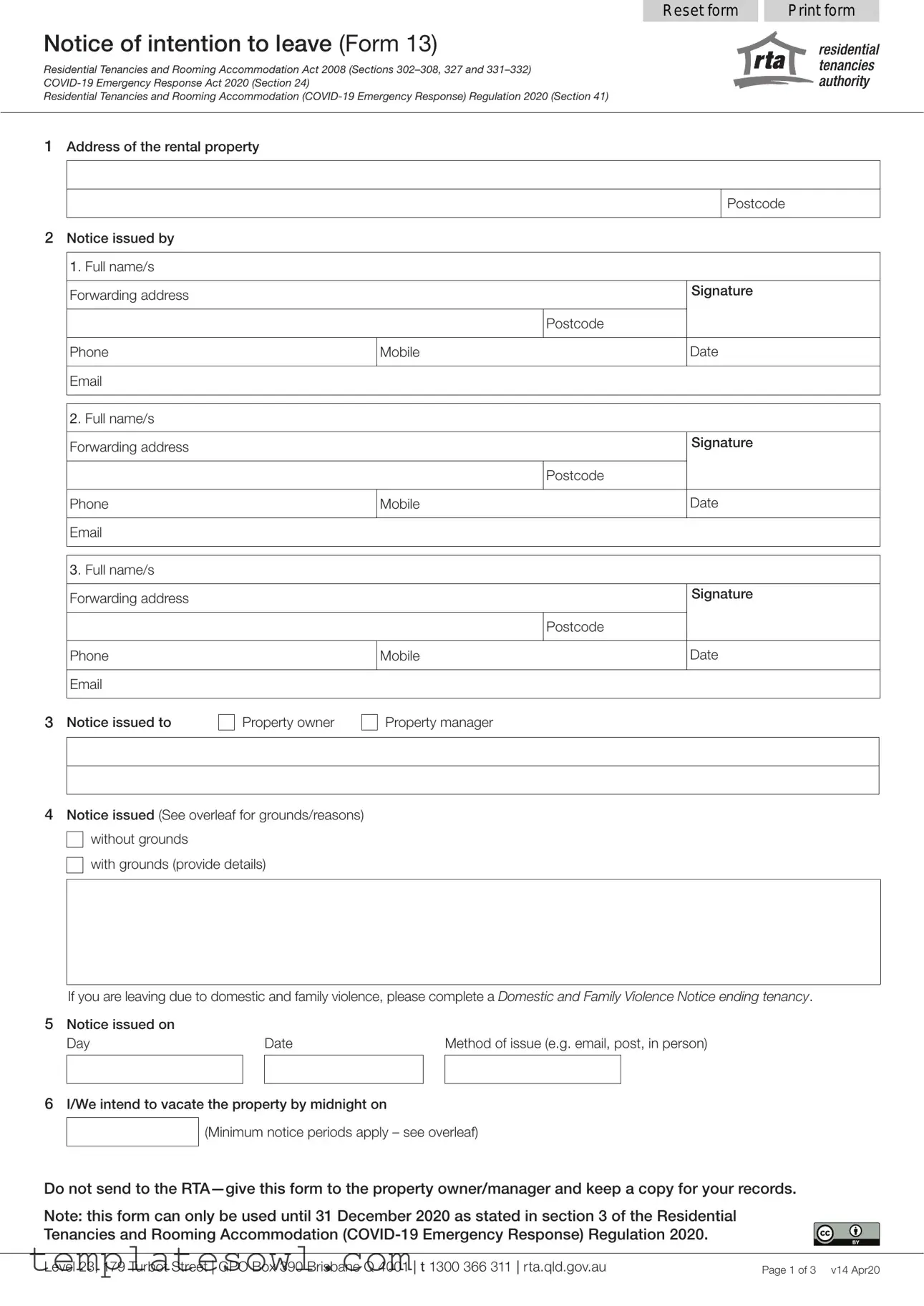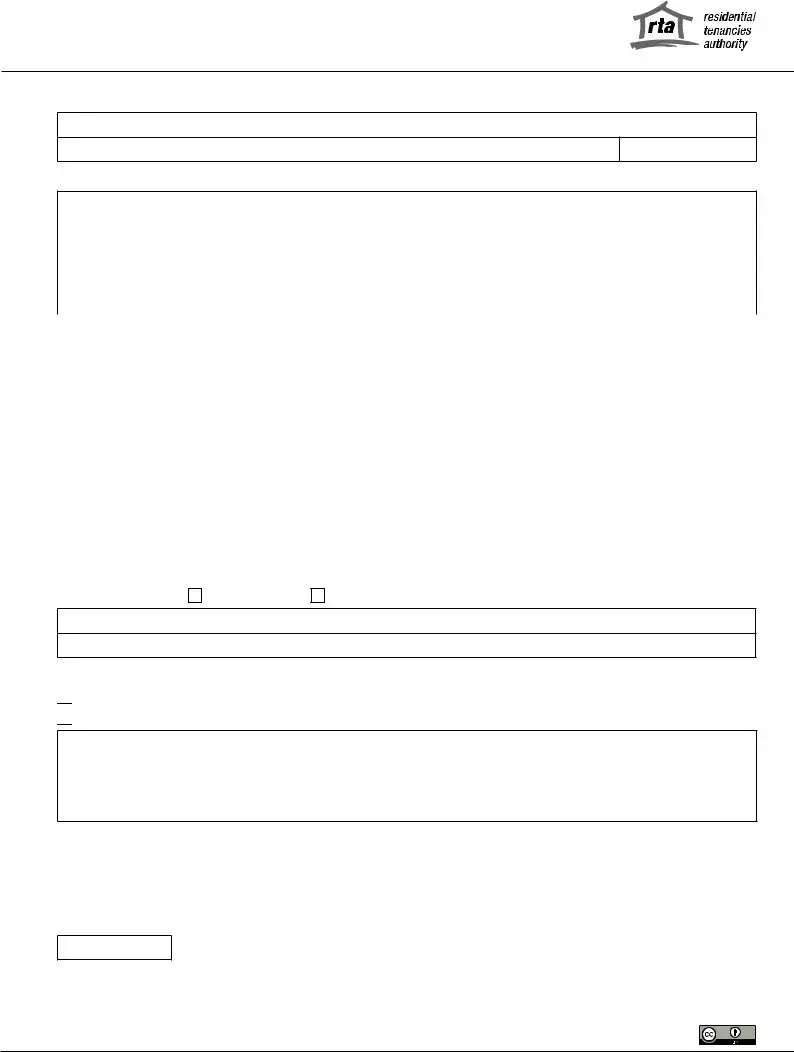Notice of intention to leave (Form 13)
Residential Tenancies and Rooming Accommodation Act 2008 (Sections 302–308, 327 and 331–332)
COVID-19 Emergency Response Act 2020 (Section 24)
Residential Tenancies and Rooming Accommodation (COVID-19 Emergency Response) Regulation 2020 (Section 41)
1Address of the rental property
Postcode
2 Notice issued by
1. Full name/s
Forwarding address |
|
|
Signature |
|
|
|
|
|
|
|
|
|
Postcode |
|
|
|
|
|
Phone |
Mobile |
|
Date |
|
|
|
|
Email |
|
|
|
|
|
|
|
|
|
|
|
2. Full name/s |
|
|
|
|
|
|
|
Forwarding address |
|
|
Signature |
|
|
|
|
|
|
|
|
|
Postcode |
|
|
|
|
|
Phone |
Mobile |
|
Date |
|
|
|
|
Email |
|
|
|
|
|
|
|
|
|
|
|
3. Full name/s |
|
|
|
|
|
|
|
Forwarding address |
|
|
Signature |
|
|
|
|
|
|
|
|
|
Postcode |
|
|
|
|
|
Phone |
Mobile |
|
Date |
|
|
|
|
Email |
|
|
|
|
|
|
|
4Notice issued (See overleaf for grounds/reasons)
 without grounds
without grounds
 with grounds (provide details)
with grounds (provide details)
If you are leaving due to domestic and family violence, please complete a Domestic and Family Violence Notice ending tenancy.
5Notice issued on
Day |
|
Date |
|
Method of issue (e.g. email, post, in person) |
|
|
|
|
|
|
|
|
|
|
|
|
6I/We intend to vacate the property by midnight on
(Minimum notice periods apply – see overleaf)
Do not send to the RTA—give this form to the property owner/manager and keep a copy for your records.
Note: this form can only be used until 31 December 2020 as stated in section 3 of the Residential Tenancies and Rooming Accommodation (COVID-19 Emergency Response) Regulation 2020.
Level 23, 179 Turbot Street | GPO Box 390 Brisbane Q 4001 | t 1300 366 311 | rta.qld.gov.au

Notice of intention to leave (Form 13)
Residential Tenancies and Rooming Accommodation Act 2008 (Sections 302–308, 327 and 331–332)
COVID-19 Emergency Response Act 2020 (Section 24)
Residential Tenancies and Rooming Accommodation (COVID-19 Emergency Response) Regulation 2020 (Section 41)
The tenant/s give this notice to the property owner/manager when the tenant/s want to vacate the premises by a certain date.
There may be a number of grounds (reasons) for giving the notice. If the property owner/manager disputes these reasons, they should try to resolve the matter with the tenants first. If agreement cannot be reached, the RTA’s dispute resolution service may be able to assist – phone 1300 366 311.
If tenants are leaving because of an unremedied breach, this notice can only be given after the 7 day remedy period has expired.
If the tenant/s are giving this notice because of an unremedied breach by the owner or manager, please note that this notice does not guarantee that you will be released from the tenancy agreement. You may apply for termination of your lease through the Queensland Civil and Administrative Tribunal (QCAT) under section 309 of the Residential Tenancies and Rooming Accommodation Act 2008.
When serving notices by post, the sender must allow time for the mail to arrive when working out notice periods.
Minimum notice periods
See the list of new and amended grounds for the COVID-19 emergency period.
General tenancies
With grounds
Grounds |
Minimum notice |
Existing or new ground |
|
|
|
The rental property is not in good repair, is unfit to |
The day it is given this has to be |
New |
live in AND this notice is provided within the first 7 |
within 7 days of taking possession. |
Note: this is only applicable during the COVID-19 |
days of the resident occupying the premises. |
|
emergency period until 31 December 2020. |
|
|
|
Unremedied breach |
7 days |
Existing |
|
|
|
Non-compliance with tribunal order |
7 days |
Existing |
|
|
|
Non-liveability |
The day it is given |
Existing |
|
|
|
Compulsory acquisition |
2 weeks |
Existing |
|
|
|
Intention to sell |
2 weeks |
Existing |
|
|
|
Without grounds |
|
|
|
|
|
Type of agreement |
Minimum notice |
Existing or new ground |
|
|
|
Periodic agreement |
2 weeks |
Existing |
|
|
|
Fixed term agreement |
14 days |
Existing |
A tenant must give at least 14 days notice, unless the property owner/manager has breached the agreement. The tenancy ends on the end date of the |
agreement or the end date of the notice period (whichever is longer). Both parties can agree to end a fixed term agreement early but it must be agreed in writing. |
|
|
|
Level 23, 179 Turbot Street | GPO Box 390 Brisbane Q 4001 | t 1300 366 311 | rta.qld.gov.au

Notice of intention to leave (Form 13)
Residential Tenancies and Rooming Accommodation Act 2008 (Sections 302–308, 327 and 331–332)
COVID-19 Emergency Response Act 2020 (Section 24)
Residential Tenancies and Rooming Accommodation (COVID-19 Emergency Response) Regulation 2020 (Section 41)
Moveable dwellings
Without grounds
Type of agreement |
Long term |
Short-term |
Existing or |
|
agreement notice |
agreement notice |
new ground |
|
period |
period |
|
|
|
|
|
The rental property is not in good repair, is unfit to |
The day it is given this |
N/A |
New |
live in AND this notice is provided within the first 7 |
has to be within 7 days |
|
Note: this is only applicable during |
days of the resident occupying the premises. |
of taking possession. |
|
the COVID-19 emergency period |
|
|
|
until 31 December 2020. |
|
|
|
|
Unremedied breach |
2 days |
n/a |
Existing |
|
|
|
|
Non-compliance with tribunal order |
7 days |
1 day |
Existing |
|
|
|
|
Non-liveability |
The day it is given |
The day it is given |
Existing |
|
|
|
|
Compulsory acquisition |
2 weeks |
1 day |
Existing |
|
|
|
|
Intention to sell |
2 weeks |
1 day |
Existing |
|
|
|
|
Without grounds
Type of agreement |
Minimum notice |
Existing or new ground |
|
|
|
Periodic agreement |
2 weeks |
Existing |
|
|
|
Fixed term agreement |
14 days |
Existing |
|
|
|
A tenant must give at least 14 days notice, unless the property owner/manager has breached the agreement. The tenancy ends on the end date of the agreement or the end date of the notice period (whichever is longer). Both parties can agree to end a fixed term agreement early but it must be agreed in writing.
Level 23, 179 Turbot Street | GPO Box 390 Brisbane Q 4001 | t 1300 366 311 | rta.qld.gov.au


 without grounds
without grounds with grounds (provide details)
with grounds (provide details)
